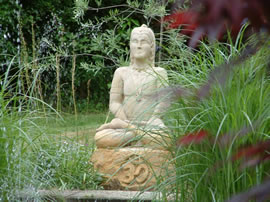Summary of first Patanjali Yoga Sutra Course
The first course on the Patanjali Yoga sutras has been completed and was well received. Those participants showed a keen interest in what the sutras were about and how they could be used in their everyday life. The sutras are short and to the point, leaving no room for misunderstanding but they have to be unpacked to discover the wealth of knowledge that they hold within them. They have to be sounded with precision, acknowledging the Science of Sound, for the correct resonances have to be formed in order for knowledge to arise. This was clearly illustrated by one student who said: “I really enjoy your teaching style and have gained a great deal from the first two classes. They have given me a deeper understanding and feeling for the sutras than before, they were only words. Thank you for delivering in such a clear and absorbable way C”.
Patanjali codified these teachings 5000 years ago in order that they may be handed down and followed by devotees generations later, it is the Science of Yoga, yogänuçäsanam. They start at the beginning -atha, and take you step by step towards Self Realisation. He clearly states in sutra two what yoga is – Yogas citta vrtti nirodhah “Yoga is the bringing to rest movements in Consciousness”. For if we do not remove these movements, that cloud our vision, we will never uncovered the Divinity within. Therefore obstacles on the path have to be identified in order to be removed. These obstacles take the form of mental modifications, more commonly known as thoughts, in Sanskrit they are called vrttis. In sutra four – ‘vrtti särüpyam itaratra’ says the main problem being that we identify with these movements, thinking we are these thoughts.
The focus of the group was realising you are not your mind nor your body. Sarvayatra the deep relaxation was used to clarify this point and come to an understanding of what Consciousness is. The cit – the clear screen of awareness that is not affected by anything, yet from which all arises. The connection between the Universal Cit and the citta, in the heart of the individual. Part of the journey was coming to an understanding of the witness awareness (drastu) that can observe both, then taking this witnessing awareness to view everyday occurrences with a different light. In short making the sutras practical and real, not just words on a page. There was much positive feedback and discussion in regard to the practice. It was a satsang environment where we worked together each contributing and bringing our own unique experiences.
We cannot help thoughts coming and going but we can start to sift the un-necessary ones out. This is done in the light of ahimsa, non harm; never criticising one’s thinking. There is no need for psycho-analysing of them, just let thoughts go, so that our vision is not clouded by these.
This course has been for those who wish to make changes in a subtle way for we are householders who have family commitments. Yoga shows us how to live our lives with vairagya – dispassion. To live in the world but not be of it. This makes actions more effective and rewarding. Instead of turning outwards, we have to reverse that, turning our attention inwards to our subtle realm. Here we will meet our mental and emotional vrttis and also asmita (our individualness, known as the ego).
Asmita (ego) is one of the five main obstacles to Self Realisation coming in the sutra 2.3 “avidya (ignorance being the predominant one), asmita, raga (liking) dvesa (disliking), abhinivesah (fear of change). These were brought out during the course as appropriate.
Thoughts are just mental modifications, it is the identifying with them that causes the problem. Sutra 4 Vrtti särüpyam itaratra. Saying this is mine (name all the possession that you have that define you; house, car, clothes, friends, job etc.) That is fine but the ignorance occurs when you say this is the real you (asmita) totally ignoring the Divinity that lies within. Our thoughts are coloured by us personally, liking this or disliking that. We seem to be defined as consumers in today’s materialistic world and we become what we buy or cannot buy; this is a very narrow, restrictive and unhealthy outlook, the course encouraged a wider perspective. In the satsang environment of the ashram, participants were able to relax and enjoy the process.
There is no quick fix, change has to happen with understanding and this is my experience, I teach from my own understanding. I incorporate meditation, the Science of Breath, yoga anatomy etc. to throw light on different aspects of the teaching. It can be challenging but very practical; part of the Science of Being and the Art of Living.
I am now on Facebook and intending to put relevant work under Oshadhi Meditation, for which you need to sign into. For any queries contact through email on vanessaegraham@aol.com . These teachings are Universal in application and open to sincere spiritual seekers, please email of your interest.
-
Feedback received
It has been lovely to meet Vanessa and other ‘yogic’ people and I hope to continue being in contact. Vanessa obviously puts a lot of work into the course and has backed this up with generous sharing of her knowledge with further reading and information. Thank you so much. More please. M
Work has been incredibly stressful and the last few weeks have been particularly challenging!
The yoga mornings have been a wonderful way to help find some balance in my life and fellowship with like minded people. Iti comes in useful in busy and stressful days too! Thanking you for creating such a sustaining and healing space at the Ashram. S
If you are hesitant about this course, just go along and embrace the day, you will love it. J
